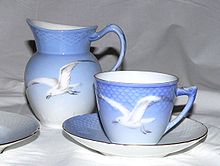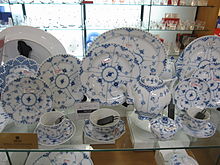- Royal Copenhagen
-
Royal Copenhagen 
Type Porcelain Manufacturer Founded 1 May 1775 Headquarters Denmark, Copenhagen Parent Axcel Website Royal Copenhagen Royal Copenhagen, officially the Royal Porcelain Factory (Danish: Den Kongelige Porcelainsfabrik) is a manufacturer of porcelain products and was founded in Copenhagen 1 May 1775 under the protection of Queen Juliane Marie. It is recognized by its factory mark, the three wavy lines above each other, symbolizing Denmark’s three straits: Oresund, the Great Belt and the Little Belt.[1]
Contents
Early years
Starting in the 17th century, Europeans were fascinated by the blue and white and white porcelain exported from China during the Ming and Qing dynasties,[2] but Danes had to discover for themselves how to produce the "white gold" (white glaze) that they found so irresistible about porcelain.
The Royal Copenhagen manufactory operations began in a converted post office in 1775. It was founded by a chemist, Frantz Heinrich Müller, who was given a 50-year monopoly to create porcelain. The first pieces manufactured were dining services for the royal family.[3] When, in 1779, King Christian VII assumed financial responsibility, the manufactory was styled the Royal Porcelain Factory. In 1790, Royal Copenhagen brought out its now famous Flora Danica ‘Blue Fluted’ dinner service, with gilded edge and Danish flora motifs,[4] and Royal Copenhagen held a monopoly on the "Blue Fluted" name.[5]
By 1851, Royal Copenhagen qualified for the World Expo in London. In 1868, as a result of royal companies' privatization, the Royal Porcelain Factory came into private hands. It was purchased by the faience factory Aluminia in 1882. Shortly after Aluminia's acquisition, Royal Copenhagen production was moved to a modern factory building at Aluminia’s site in Frederiksberg, on the outskirts of Copenhagen. By 1889, Royal Copenhagen qualified for the World Expo in Paris, winning the Grand Prix, giving it international exposure.
Current company
In recent years, Royal Copenhagen acquired Georg Jensen in 1972, incorporated with Holmegaard Glass Factory in 1985, and finally Bing & Grøndahl in 1987. Today, Royal Copenhagen is a part of a group of Scandinavian companies, Royal Scandinavia, together with Georg Jensen, and is owned by the Danish private equity fund, Axcel. Following Axcel's acquisition of Royal Scandinavia, Holmegaard Glasværk was sold in a MBO and a controlling interest in the Swedish glass works Orrefors Kosta Boda was sold to New Wave Group. In April 2008 it was reported that Royal Copenhagen was moving nearly all of its production to Thailand.[6]
Patterns (original manufacturer in parentheses)
Most famous
- Flora Danica, Blue Fluted (in Danish: Musselmalet), Blue Flower, Henriette, Saxon Flower, Fan, Gemina, and Gemma (Royal Copenhagen)
- Empire, Offenbach, Butterfly, and Seagull (Bing & Grøndahl)
- Tranquebar and Blue Line (Aluminia).
New
- Black Mega, Palmette, White Plain, White Half Lace, White Full Lace, Blue Flower Curved and Plain, White Pot, Blue Line, the new Christmas service Star Fluted, and Ole.[7]
Discontinued
- Gemina, Gemma, Jingle Bells, and Julian Marie (Royal Copenhagen)
- Seagull (without gold trim), Blue Henning Koppel, White Henning Koppel, Tema, Mexico (Bing & Grøndahl)
Collectibles
- Royal Copenhagen 2010 plaquettes: Numbered and named faience plates depicted a variety of scenes, holidays, years, and occasions. Most commonly round, they measured about 8 cm (3-1/4") in diameter, with a blue scene on white background.
- Larger, approximately 7-1/4", blue on white faience plates, created annually for Mother's Day, the Olympics, and other commemorations. Some weren't annual issues, instead depicted scenes. In 1895, Royal Copenhagen began producing annual Christmas plates, still in production today [1]
- Porcelein pipes, beginning in 1969 and manufactured for about 15 years.
Further reading
- Bojesen, Benedicte, and Steen Nottelmann. Royal Copenhagen Art, Industry. Lyngby: Sophienholm, 1996. ISBN 8787883570
- Christoffersen, Lars. Christmas Plates & Other Commemoratives from Royal Copenhagen and Bing & Grøndahl. A Schiffer book for collectors. Atglen, PA: Schiffer Pub, 2004. ISBN 0764320890 Table of contents
- Heritage, Robert J. Royal Copenhagen Porcelain Animals and Figurines. A Schiffer book for collectors. Atglen, PA: Schiffer Pub, 1997. ISBN 0764301012
- Kongelige Porcelainsfabrik, Bredo L. Grandjean, Dyveke Helsted, and Merete Bodelsen. The Royal Copenhagen Porcelain Manufactory 1775-1975. Copenhagen: The Manufactory, [eksp., Amagertorv 6], 1975. ISBN 8798034219
- Pope, Caroline, and Nick Pope. A Collector's Guide to Royal Copenhagen Porcelain. A Schiffer book for collectors. Atglen, PA: Schiffer, 2001. ISBN 076431386X
- Wagner, Peter, Steen Nottelmann, Finn Andersen, and Paul Nesbitt. Flora Danica. Edinburgh: Royal Botanic Garden, Edinburgh, 1994. ISBN 0952386909
- Winstone, H. V. F. Royal Copenhagen. [London]: Stacey International, 1984. ISBN 0905743377
References
- ^ "History timeline". Royal Copenhagen. Archived from the original on 2008-01-02. http://web.archive.org/web/20080102132745/http://www.royalcopenhagen.com/Craftmanship/The-history-of-Royal-Copenhagen/History-timeline.aspx. Retrieved 2007-08-19.
- ^ Lu Chenglong. "A Brief Introduction to Chinese Ceramics in Sweden". Gotheborg.com. http://www.gotheborg.com/exhibition/chenglong.shtml. Retrieved 2007-08-19.
- ^ http://www.danishpipemakers.com/articles/porcelain/porcelain.html accessdate 2007-08-19
- ^ http://americanairlines.wcities.com/en/record/217,85812/99/record.html accessdate 2007-08-19
- ^ http://www.dphtrading.com/inf.aspx?id=119&l=2 accessdate 2007-08-19
- ^ Ministry of Foreign Affairs of Denmark. "ROYAL COPENHAGEN TO THAILAND". Denmark.dk. Archived from the original on 2008-05-03. http://web.archive.org/web/20080503040052/http://www.denmark.dk/en/servicemenu/News/BusinessNews/RoyalCopenhagenToThailand.htm. Retrieved 2008-04-11.
- ^ http://www.royalcopenhagen.org/index1.html accessdate 2007-08-19
External links
 Media related to Royal Copenhagen at Wikimedia Commons
Media related to Royal Copenhagen at Wikimedia CommonsSee also
- Porcelain manufacturing companies in Europe
Porcelain China Chinese porcelain · Chinese export porcelain · Chinese influences on Islamic pottery
Types: Proto-celadon (16th century BCE) · Celadon (1st century) · Yue (2nd century) · Jingdezhen (6th century) · Sancai (8th century) · Ding (10th century) · Qingbai (12th century) · Blue and white (14th century) · Blanc de Chine (14th century) · Kraak (16th century) · Swatow (16th century) · Kangxi (17th century) · Famille jaune, noire, rose, verte (17th century) · Tenkei (17th century) · Canton (18th century)Korea Types: Joseon (14th century)Japan Europe French porcelain · Chinese porcelain in European painting
Types: Fonthill Vase (1338) · Medici (1575) · Rouen (1673) · Nevers · Saint-Cloud (1693) · Meissen (1710) · Chantilly (1730) · Vincennes (1740) · Chelsea (1743) · Oranienbaum (1744) · Mennecy (1745) · Bow (1747) · Nymphenburg Porcelain Manufactory (1747) · Plymouth (1748) · Worcester (1751) · Frankenthal Porcelain Factory (1755) · Sèvres (1756) · Derby (1757) · Wedgwood (1759) · Wallendorf (1764) · Etiolles (1770) · Limoges (1771) · Clignancourt (1775) · Royal Copenhagen (1775) · Revol (1789) · Herend Porcelain Manufactory (1826) · Zsolnay (1853)Technologies People Ehrenfried Walther von Tschirnhaus · Johann Friedrich Böttger · Francois Xavier d'Entrecolles · Dmitry VinogradovCollections British Museum (London): Asia Department / Percival David Foundation · Dresden Porcelain Collection · Gardiner Museum (Toronto) · Kuskovo State Museum of Ceramics (Moscow) · Musée national de Céramique-Sèvres (Paris) · Musée des Arts Décoratifs (Paris) · Palace Museum (Beijing) · Topkapı Palace (Istanbul) · Victoria and Albert Museum (London) · Worcester Porcelain MuseumCategories:- Ceramics manufacturers of Denmark
- Royal Copenhagen
- 1775 establishments in Denmark
- Porcelain
- Purveyors to the Court of Denmark
- Vesterbro
Wikimedia Foundation. 2010.





